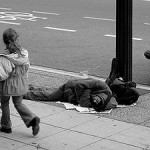 There are many curiosities when it comes to social psychology, and in particular how we often tend to behave when in groups. With the rise of social networks, these phenomenon take on a new level of interest. One of the more interesting is the bystander effect. This suggests that the more people are gathered in one place, the less likely any of them are to help someone in need. The theory is that everyone palms off responsibility to the others in the crowd, thus resulting in no one offering to help at all.
There are many curiosities when it comes to social psychology, and in particular how we often tend to behave when in groups. With the rise of social networks, these phenomenon take on a new level of interest. One of the more interesting is the bystander effect. This suggests that the more people are gathered in one place, the less likely any of them are to help someone in need. The theory is that everyone palms off responsibility to the others in the crowd, thus resulting in no one offering to help at all.
So how does this apply to the Internet and our world of hyperconnectivity via social networks? Does our constant involvement in massive online communities result in us being less prone to help one another? After all, the bystander effect was coined long before the rise of social networks.
Researchers at the University of Copenhagen have attempted to bring the science into the 21st century. On the surface, the experiments seemed quite standard. Each involved an actor falling in the middle of Copenhagen city centre. Some involved a young woman, others a young man, whilst others saw an elderly gentleman taking a tumble. Further variance was applied via the outfits each actor wore. Some for instance were smartly attired, whilst others were shabbily dressed.
As you may expect, the outfits people wore had a big impact on the help they received. Those in smart outfits for instance would often get help in seconds. Their shabby peers however would often have to wait for several minutes for assistance.
The experiment also revealed that people are influenced not just by the dress of those in need, but also by influential people in their midst. For instance, if a tour party passed by the scene and the guide did not stop to help, neither did any of their party.
The researchers have aggregated their observations and are in the process of creating a virtual simulation that takes into account the various factors they observed throughout their experiments. They hope that this will give them a good indication of when people will choose to help within their virtual environment.
We’ve seen a similar kind of trend online with various measures of social proof influencing how people behave, whether that’s in supporting a charity on Facebook or fundraising on Kickstarter. With signals of behaviour so prevalent online, it is perhaps not surprising that our individual behaviours are so influenced by the group we are in.
Likewise, we have seen with charities that it is easy to register ‘support’ without actually doing anything meaningful to help, which in its own way is a form of the bystander effect. It will be interesting to see the outcome of the study when it’s published, but one thing does seem certain. Whilst we like to think that our decisions are largely rational ones, research such as this suggests they are really anything but.
There was a video doing the rounds about this a wee while back. Basically a homeless looking guy falling over coughing vs a smart looking guy doing the same. The response was quite shocking.